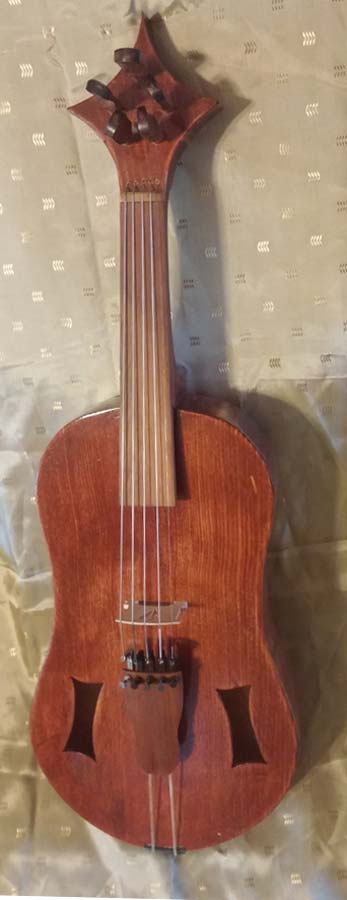A fyddle is a difficult thing to tie down. In some languages, the word for fyddle (fiddle) simply means stringed instrument. In others, it is very specific. There are dozens, if not hundreds of words that convey part or all of the meaning of fyddle. But for the sake of clarity, we are going to once and for all put to rest this problem, and declare "A Fyddle is a pre-viol era bowed stringed instrument that doesn't belong specifically to any other classification". So while in some places a Jouhikko may be a horsehair fyddle, and in others a rebec may be a fyddle, not here.
The generic fyddle came in many sizes, shapes, string counts, construction methods, in fact, there are probably more options available to fyddle buyers than with any other instrument. Oval, box, square, pear, waisted, trapezoidal, diamond, even zoomorphic carved instruments. Big, small, shrill, with frets or without, the fyddle was almost all things for all purposes. And we can build them (well, at least most of them).
The tradition of the fyddle is actually alive and well in many other nations among the folk performers, but as far as it's important, relevant courtly and high-ststus time, that ended pretty much the minute the first viol was built. Such a shame, in a way, but understandable in others. However, the meaningful music written for these fyddles still has incredible value, and their sound is unique and useful even in today's tonal landscape. While long since 'dead' to the prim and proper music world, they are far from extinct, and the renaissance of older sound occurring today is incredible.
We base our instruments on archaeological evidence, historical art and written documentation, but we do not replicate these instruments. Instead, we choose to take what we know from these sources and our own experience, mix in the imagination of the customer, occasionally add in a drop of technological magic, and create what a fyddle builder of this era would have created, a unique piece for his client. So drop us a message or give us a call. We promise, we won't charge to answer your questions.

Pochette (Kit) Fyddle
The last hurrah of the
early fyddle family, this small instrument was designed
to allow a violin playing style with a soft but
authoritative voice, suitable for a concertmaster while
working rehearsing his orchestra or a dance instructor
teaching in a smaller parlor, as well as for
entertaining the lads at the local pub. The kit,
while resembling a viol in many ways, still did not have
a bass bar, a soundpost, and retained the flat or curved
top of the early fyddle. It was integrated into
novelty items like the fyddle-stick, a walking stick /
fyddle combination. This small branch of the
fyddle family tree maintained a dignified and important
place in the world of viols well into the 1800s.

As the requirements of players changed, the traditional rebec and it's limited volume and playing style became unsuitable for some of the music being played. Instruments with more strings, a more fully developed curved bridge and sometimes even a matching curved fingerboard, a flatter nose and back to facilitate playing at the chin, and a larger sound cavity came into being. While technically minor improvements on the rebec, as the unbraced, flat or lightly curved soundboard, lack of soundpost or bass enhancement and corpus built (carved entirely from one piece of wood) body were still characteristics of the vielle, the improvements made in small areas carried into the development of the viol family. This five stringed waisted vielle is one of the versions that had the biggest influence on those who would build viol instruments. It is loud and bright and has a good range, but still has a flat fingerboard and curved bridge, making it suited especially for the double-stopped and droning style most common to fyddles for centuries. The vielle was built round, teardrop, oval, square, rectangular, trapezoidal, in so many sizes and forms. There are large blocks of wood in our shop, perhaps one of them is hiding your vielle within it's mysterious interior?